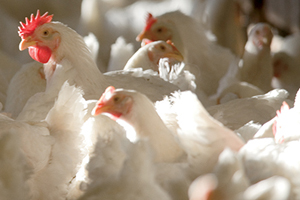Research investigates cyanosis in male broiler chickens

The cause of cyanosis in male breeder broilers has been investigated in a research project led by Dr Danny Magee at Mississippi State University.
The research project, funded by USPOULTRY and the USPOULTRY Foundation, investigated the cause of cyanosis, a dark blue or purple coloration of the skin, comb, and wattles, and has been seen in the industry for several years. The research found that the underlying cause may be a cardiac problem affecting blood flow in the male breeders. The project investigated the contributions of feeding programs on the incidence of the condition.
The project was primarily designed to evaluate the cardiac function of broiler breeder males. Males of three different breed strains from multiple production companies were evaluated over the course of the project. After echocardiography, the males were necropsied and the hearts collected for further histopathological evaluation. Information gathered included body weights; breast fleshing scores; blood parameters such as cholesterol, hematocrits, nitrates; and heart function analysis of the left side of the heart.
The initial concerns with cyanosis were that these males may have had a respiratory and/or a circulatory problem. It was found, in evaluation of birds on the farm that higher average body weights and higher average fleshing scores were both associated with lower incidences of cyanosis. Also, higher hematocrits correlated with an increased incidence of cyanosis. On first impression, the body weight and fleshing data suggest that proper nutrition and feeding management in broiler breeder males is important in the prevention of cyanosis on the farm. Proper feeding management should also reduce the need for males to eat manure.
Since the project was designed to work with mature broiler breeder males, it is easy to draw conclusions focused on the mature bird. However, the authors cannot exclude the possibility that the body weight and fleshing data are the result of a heart abnormality that was present in these males at a young age rather than the cause of a heart abnormality later in life. If this were to be the correct conclusion, feeding practices beginning at day one could still help lessen the impact of the abnormality but would be unlikely to correct it. As with other species, heart health is vitally important for the overall health and well-being of the breeder male.








